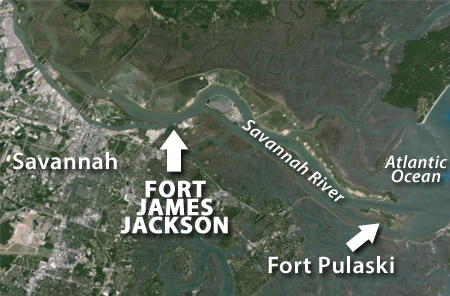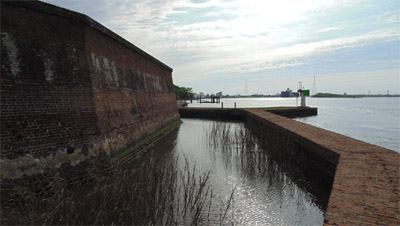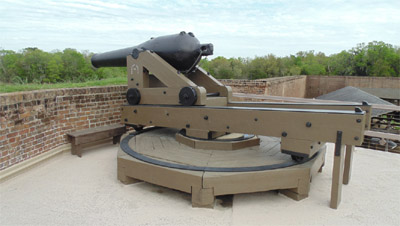 |
Fort James Jackson
Savannah, Georgia, USA
|
|
 |
Constructed: 1808-1812
Used by: USA, CSA
Conflict in which it participated:
US Civil War
Also know as: Fort Oglethorpe,
Old Fort Jackson
|
Fully manned and ready to defend the city of Savannah for both the War of 1812 and the US Civil War, little Fort James Jackson was only fired upon once, ironically by the CSS Savannah.
The city of Savannah was founded on February 12, 1733, by dude-destined-to-have-many-many-things-named-after-him-in-Georgia, Englishman James Oglethorpe (1696-1785). |
 |
 |
|
When Oglethorpe and his seasick band of brothers landed at what would become Savannah, he was met by the Tomochichi and Yamicraw Indians. I mention this only because I really like the word Yamicraw.
The spot at which Fort James Jackson would be built was identified as a strategic point during the American Revolutionary War (1775-1783), as it commanded an unusually deep part of the Savannah River called Five Fathom Hole, just a wee bit downstream of the city itself. Oceangoing ships frequently anchored at this "hole" until the tide came in, making it possible to proceed to the city's docks.
By 1778 it became necessary to build a defensive position to keep the British out of Savannah, which was the southernmost port of America's thirteen colonies. An earthen battery with the undistinguished name of Mud Fort was pattycaked into existence at Five Fathom Hole at the beginning of 1778, under the command of a Captain Thomas Lee, who immediately perished from malaria in February of 1778. Apparently Lee had been the only thing holding this battery together, because once he was gone it was abandoned, and the British fleet sailed sublimely past the deserted pile of mud, likely unaware of its existence, later that year. Savannah fell to the British on December 29, 1778.
|
| Fort James Jackson's weird curved gun platform makes for very interesting little pie-slice casemates! |
 |
Savannah was finally reclaimed by the Rebels on July 11, 1782. At the forefront of the victorious Georgia militia as it took possession of the city was Brigadier General James Jackson (1757-1806), who would go on to become both a US Senator representing Georgia, and Georgia's 23rd Governor...and would have a pseudo-starfort named after him.
Despite president Thomas Jefferson (1743-1826)'s determination that America should remain aloof from Europe's endless orgy of self-consuming war, the mounting tension that would result in the Napoleonic Wars (1803-1815) made it virtually impossible for America to pursue commercial enterprise on the open seas...and it was only a matter of time before somebody started pounding on American ports. In November of 1807, the House of Representatives resolved that it is expedient to cause the President of the United States to cause such fortifications to be erected...which will...afford effectual protection to our ports and harbors.
A tiny, poor excuse for a fortlet called Fort Green had been built at the mouth of the Savannah River in 1791, but in 1804 a storm had flooded it out of existence, drowning some of its garrison. This left Savannah relatively defenseless, and it was considered a likely target of attack, due to its strategic importance and small proportion of white residents: Plenty of slaves were there, but would they lift a finger to defend Savannah? I certainly would not in such a situation. |
|
|
Henry Dearborn (1751-1829), Jefferson's Secretary of the Treasury, wrote that Savannah needed a regular enclosed work, with six heavy cannon. Work on those forts deemed necessary to defend Georgia and South Carolina was begun in 1808, under the direction of Major Alexander Macomb (1782-1841). Macomb would be the hero of the Battle of Plattsburgh (September 11, 1814) in the upcoming War of 1812 (1812-1815), but more importantly was the namesake of awesome starfort Fort Macomb, built in 1822 just outside New Orleans. The Republican and Savannah Ledger first published the name of the fort of our current interest as Fort Jackson on January 4, 1809. "Leased slaves" were used for the grunt work of the fort's construction. The demonstrable presence of this group did not please Savannah's genteel residents, but they wouldn't dirty their feathery paws and make themselves a fort. You can't have it both ways, Savannah. But you sure can complain about it.
|
Funding for the desperately important work of fortifying America's shores never lasted much beyond the initial enthusiasm for such endeavors. Money ran out and construction of Fort James Jackson ceased in late 1810, after its two barracks buildings had been completed. With war almost a certainty, Congress finally appropriated the nice round figure of $160,303.86 for fort construction in 1811, $11,571.42 of which was set aside for Georgia and South Carolina.
By the official start of the War of 1812 on June 1, 1812, Fort James Jackson had eight guns mounted, but not one soldier for its defense, or to secure it from insult. The 8th United States Infantry was swiftly created, which unit moved into the mostly-complete Fort James Jackson on July 5, 1812.
|
 |
Yes, this picture is also on this site's Fort Pulaski page, as Fort James Jackson and Fort Pulaski are forever intertwined due to their locations relative to one another. But it's such an awesome picture. N'est pas? |
|
The Fort James Jackson that was completed in the summer of 1813 wasn't the masonry powerhouse that it is today: A wooden palisade protected the rear of the fort, which was primarily a stout, raised gun platform, two barrack buildings and a hot shot furnace. It was noted with some dismay that the fort's guns couldn't reach all the way across the river, falling at most 20 to 30 feet from the opposite shore.
Which didn't matter, because the British never came anywhere near Savannah during the war. More of a threat to the fort's garrison than Royal Marines was the environment. As an 1819 newspaper article put it, Fort Jackson (is) one of the most distempered spots on earth, in the midst of fogs and poisons of a putrid marsh. And a marsh of course also means mosquitoes-a-plenty. Desertions of troops serving at Fort James Jackson were common in the years after the war.
|
 Fort James Jackson's moat, along the front gun platform. |
 |
Simon Bernard (1779-1839), French starfort designer extraordinaire, comes up a lot in the stories of American starforts. Kicked out of France after Napoleon (1769-1821) was finally vanquished in 1815, Bernard was contracted by the US government to head the Bernard Board, which looked into America's coastal defenses with an eye towards preventing Great Britain from burning Washington DC again, as they did during the recent war. Bernard was responsible for the design of such dreamy American starforts as Fort Monroe, Fort Adams and Fort Pike, among many others. |
|
|
The Bernard Board noted that between Fort James Jackson and Tybee Tower, a martello tower built in 1815 on Cockspur Island at the mouth of the Savannah River, Fort Jackson would most definitely be the one deserving of further development. Repairs and some modernization were carried out at the fort in 1823, but by 1826 there were again concerns about its dilapidated state, plus men stationed there tended to become sick and die. Work on Fort Pulaski began in 1829, and suddenly nobody had any interest in Fort James Jackson any longer. Except vandals! A local newspaper reported in 1833 that Fort Jackson's buildings had been burned. By vandals. The newly-buildingless Fort Jackson was left to wither on the vine for 15 years, but by the time work on Fort Pulaski was being wrapped up in the 1840's, the thought that it might be nice if Savannah had a second line of defense had come into play. A new effort to whip Fort James Jackson back into shape progressed through the 1850's, with most of the work being done by Irish immigrants. It became necessary to stop work through the "fever season," which was generally June through November, but even with this precaution the death rate from varying wasting diseases was notable.
|
As part of the gleeful preparation for the US Civil War (1861-1865), Georgia militias started taking over Federal things in Georgia in January of 1861. Fort James Jackson had been mostly completed by the beginning of 1860, but, as was the case with lots of those Federal places in the south in 1860, was manned by a single caretaker sergeant when the Georgia militia came a-callin' on January 3, 1861. Fort James Jacskon and Fort Pulaski were manned by newly-established Georgia militia units.
 |
 An 8 inch Colombiad mounted at Fort James Jackson. An 8 inch Colombiad mounted at Fort James Jackson. |
|
|
While the first shot fired at Fort Sumter on April 12, 1861 was supposedly lit off by Virginia firebrand and secession advocate Edmund Ruffin (1794-1865) (which I mention chiefly because I live just down the street from the dude's home), the last shot fired in that bombardment was just as supposedly lit off by a Savannah resident and member of the Republican Blues, a local military unit that had garrisoned Fort James Jackson for a time. The bombardment and capture of Fort Sumter in Charleston, South Carolina, officially began the US Civil War.
|
| From a display inside the fort; Fort James Jackson in 1864. |
 |
The residents of Savannah's initial reaction to the secession of their state and declaration of war was, yay! Excursion boats popped up and down the Savannah river, taking joyous Savannah-ers on sightseeing cruises past those new bastions of the Confederacy, Forts Pulaski and James Jackson.
Federal forces shelled the crap out of, and then captured the snot out of, two Confederate (sand) forts on Hilton Head Island in November of 1861, which was just 25 miles north of Savannah. The boys in blue set up a massive armed supply dump at Hilton Head, which served as a forward operating base against the southrons. The US Navy effected an extremely effective blockade of southern ports, and Savannah began to slowly starve.
Fort Pulaski was pounded into submission on April 11, 1862. Union forces used batteries of new rifled cannon sited far outside the range of Fort Pulaski's guns, in one of several events of this war that made everyone paying attention aware that the era of the masonry fortification as a defensive concept was rapidly coming to a close. |
|
|
Around the time Union forces were capturing Hilton Head Island, Robert E. Lee (1807-1870) was assigned to oversee the defenses of South Carolina and Georgia. By November of 1862, Fort James Jackson was armed with one 32 pounder rifled navy gun, five 32 pounder navy guns and three 18 pounders. There was at least one battery ("Alligator Battery") on the Savannah River a little east of the fort, and the river had been littered with underwater obstacles two miles downstream. These "torpedoes, brick piers and iron-tipped obstructions" kept Union gunboats from approaching Fort James Jackson and/or Savannah.
|
These obstructions did their job admirably for two years, keeping the Yankee navy from Savannah. William Tecumseh Sherman (1820-1891), however, brought his Union horde to Savannah and captured it on December 21, 1864, as the culmination of his March to the Sea.
Savannah's defenses had been oriented towards the river, and some of Fort James Jackson's guns and much of its garrison had been sent to hasty fortifications of the city's western side. By the time elements of the 28th Pennsylvania and 29th Ohio entered the abandoned Fort James Jackson, they found its guns spiked, magazine booby-trapped and barracks and kitchen burned.
The moment the US flag was raised o'er Fort James Jackson, the one remaining ironclad vessel of the Confederate Navy still skulking in the area, CSS Savannah, fired on the fort. This was the only time in history the fort has ever been directly fired upon, ironically enough by a vessel bearing the name of the city the fort was built to protect. The Savannah was struck by fire from a field gun a little bit up the river, retired upstream, and was heroically blown up by its crew that evening.
|
 |
A map of the Confederate defenses of Savannah, published in the early 1880's, featuring details of many weird little batteries and fortlets. Click it, it's huge! You rock, Library of Congress. |
|
Following the war, plans were made to upgrade Fort James Jackson, including strengthening its walls and mounting massive 15" guns. The city was much more interested in clearing the obstructions from the river, however, so Savannah could resume commercial activity. Some halfhearted work was initiated on the fort in the 1870's, but Congress pulled the plug on all fortification projects in 1877. Fort James Jackson was primarily used to store equipment used in the river-clearing effort. There is of course another Fort Jackson, on the Mississippi south of New Orleans. Although Fort James Jackson beat Fort Jackson into existence by 14 years, New Orleans' fort was named after Andrew Jackson, whom American history remembers much better than James Jackson. Fearing massive, bowel-emptying confusion if there continued to be two Forts Jackson, Fort James Jackson was officially renamed Fort Oglethorpe in 1884. A single Fort Keeper stayed at "Fort Oglethorpe" through the end of the 19th century, battling mosquitoes and drunken sailors. The fort was finally removed from US Army rolls in 1905. Its guns were removed, Keeper dismissed, and the fort was abandoned.
|
Fort James Jackson's southwest corner, which features a precariously-mounted flanking gun and some truly charming restrooms. |
 |
Over the next 60 years, the empty and rotting fort was owned by the city of Savannah and the American Cyanamid Company. Cyanamid, a vast conglomerate that made everything from decorative laminates to desulferization catalysts (and everything in between, except for ice cream), inherited the fort when it bought up Savannah's Southeastern Shipyard. After years of trying to think of something to do with the fort, the company ultimately planned to sell it off as brick scrap in 1958. This wicked (though slightly understandable) plan finally goaded the state of Georgia into taking over Fort James Jackson. |
|
|
The Georgia Historical Commission built a road to Fort James Jackson, commenced archaeological endeavors and reconfigured its insides to house exhibits. The fort was open as a maritime museum until 1975, when budget cuts forced its closure. Happily, the Coastal Heritage Society took over and reopened the fort the following year. Finally, Fort James Jackson was named a National Historical Landmark in 2000. It is Georgia's oldest standing brick structure, and one of only eight Second System fortifications still in existence today. and, I visited it in April of 2014! If you've gotten this far, won't you investigate Fort James Jackson in the Starforts I've Visited section? 2023 addendum: In the AMC-TV series Fear the Walking Dead, which aired from 2015 until 2023, there was, within the zombie apocalypse world that this series depicted, a safe haven known as PADRE. Our heroes fought and died to protect, claim, capture and seek out this mysterious location, which wasn't revealed until the very last episode. And somewhat unsurprisingly, Fort James Jackson was used as the location for PADRE. Because really, what would be a better place in which to survive during a zombie apocalypse, than a starfort?
|
|
|
|
|
|
 |




